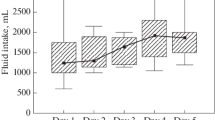Abstract
Studies of the mechanisms of visual analyzer adaptation in remote space missions are of paramount importance in the domain of space medicine. Pathogenesis of ocular nerve edema, the fundamental symptom of space-flight associated neuro-ocular syndrome (SANS), remains unclear. One of the hypothesized SANS triggers is a change of the pressure gradient in the cribriform plate due to fluctuations of both the intracranial and intraocular pressures in the absence of gravity. This study extends the study of ocular hydrodynamics under simulated 5-day microgravity. The article presents the results of a study of intraocular hydrobalance after a 21-day “dry” immersion. The study involved eight male subjects at the age of 24 to 35 years. Data of electron tonography and diurnal intraocular pressure measurements were correlated with the fluid balance dynamics. Changes in eye tonography parameters were registered after 21-day dry immersion exposure. An ocular hydrodynamics disbalance was registered in 80% of the subjects. Tonography revealed clinically significant changes in 25% of the subjects. The results made it possible for the first time to assess the severity and nature of the autoregulation of ocular hydrodynamics under conditions of compensatory hypohydration of the body due to a simulated 21-day gravitational unloading.





Similar content being viewed by others
REFERENCES
Marthy, G. Marchbars, R.S., et al., Increased intracranial pressure in human during simulated microgravity, Physiologist, 1992, vol. 35, p. 184.
Morgan, W.H., Yu, D.Y., and Balaratnasingam, C., The role of cerebrospinal fluid pressure in glaucoma pathophysiology: the dark side of the optic disc, J. Glaucoma, 2008, vol. 17, p. 408.
Volkov, V.V., About the putative mechanisms of visual impairment in glaucoma, in Aktual’nye problemy oftal’mologii (Current Challenges in Ophthalmology) (Sci. Pap. Devoted to 100th Anniversary of M. I. Averbakh), Moscow, 1974, p. 45.
Kuroedov, A.V., Gorodnichiy, V.V., Tsalkina, E.B., et al., About the correlation between IOP fluctuations and the morphometric structure of the optic nerve, Oftal’mologiya, 2006, no. 1, p. 43.
Watanabe, A., Kinouchi, H., Horikoshi, T., et al., Effect of intracranial pressure on the diameter of the optic nervesheath, J. Neurosurg., 2008, vol. 109, p. 255.
Kondzhariya, M.V., Pathology of the optic nerve in post-contusion hypotonic syndrome, Cand. Sci. (Med.) Dissertation, Moscow, 2004.
Draeger, J., Schwartz, R., Groenhoff, S., et al., Self-tonometry under microgravity conditions, Clin. Invest., 1993, vol. 71, p. 700.
Van Ombergen, A., Jillings, S., Jeurissen, B., et al., Brain ventricular volume changes induced by long-duration spaceflight, Proc. Natl. Acad. Sci. U.S.A., 2019, vol. 116, no. 21. https://doi.org/10.1073/pnas.1820354116
Mader, T.H., Gibson, G.R., et al., Intraocular pressure and retinal vascular changes during transient exposure to micro-gravity, Am. J. Ophthalmol., 1993, vol. 115, no. 3, p. 347.
Man’ko, O.M., Smoleevskiy, A.E., Tomilovskaya, E.S., and Kozlovskaya, I.B., Influence of five-day “dry” immersion on the state of the hydrodynamics of the eye, Aviakosm. Ekol. Med., 2019, no. 5, p. 22.
Maslennikov, A.I., O sutochnykh kolebaniyakh vnutriglaznogo davleniya (Daily Fluctuations in Intraocular Pressure), Moscow, 1905.
Burgoyne, C.F., A biomechanical paradigm for axonal insult within the optic nerve head in aging and glaucoma, Exp. Eye Res., 2011, vol. 93, p. 120.
Ignat’eva, S.G., Shilkin, G.A., Yartseva, N.S., and Baboshina, N.N., Intraocular fluid dynamics and eye homeostasis, Klin. Oftal’mol., 2010, no. 3, p. 74.
Gazenko, O.G., Grigoriev, A.I., and Natochin, Ju.V., Water—salt homeostasis and a space flight, in Problemy kosmicheskoi meditsiny (Challenges in Space Medicine), Moscow, 1973.
Grigoriev, A.I. and Egorov, A.D., Mechanisms of homeostasis formation during prolonged exposure to microgravity, Aviakosm. Ekol. Med., 1998, no. 6, p. 20.
Author information
Authors and Affiliations
Corresponding author
Additional information
Translated by A. Deryabina
Rights and permissions
About this article
Cite this article
Man’ko, O.M., Smoleevsky, A.E. & Tomilovskaya, E.S. Change in Eye Hydrodynamics as a Pathogenesis Factor of Space-Flight Associated Neuro-Ocular Syndrome (SANS). Hum Physiol 48, 856–862 (2022). https://doi.org/10.1134/S0362119722070131
Received:
Published:
Issue Date:
DOI: https://doi.org/10.1134/S0362119722070131




